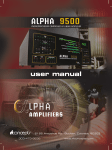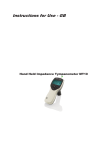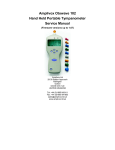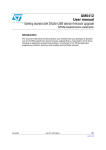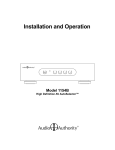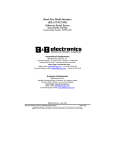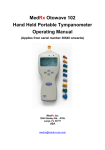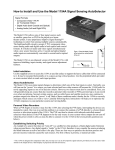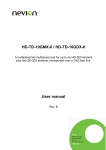Download Cisco 2525 - 2525 TR Router User guide
Transcript
2 CHAPT E R Preparing to Install the Cisco 2524 and Cisco 2525 Routers This chapter describes the tasks you must perform before you begin to install the Cisco 2524 and Cisco 2525 routers, and includes the following sections: • • • • • • Safety Recommendations General Site Requirements Installation Checklist Creating a Site Log Preparing to Connect to a Network Inspecting the System Safety Recommendations Follow these guidelines to ensure general safety: • • • • Keep the chassis area clear and dust-free during and after installation. • Wear safety glasses if you are working under any conditions that might be hazardous to your eyes. • Do not perform any action that creates a potential hazard to people or makes the equipment unsafe. Put the removed chassis cover in a safe place. Keep tools away from walk areas where you and others could fall over them. Do not wear loose clothing that could get caught in the chassis. Fasten your tie or scarf and roll up your sleeves. Preparing to Install the Cisco 2524 and Cisco 2525 Routers 2-1 Safety Recommendations Warning Ultimate disposal of this product should be handled according to all national laws and regulations. (To see translated versions of this warning, refer to the appendix “Translated Safety Warnings.”) Maintaining Safety with Electricity Follow these guidelines when working on equipment powered by electricity. Warning Before working on equipment that is connected to power lines, remove jewelry (including rings, necklaces, and watches). Metal objects will heat up when connected to power and ground and can cause serious burns or can weld the metal object to the terminals. (To see translated versions of this warning, refer to the appendix “Translated Safety Warnings.”) • Locate the emergency power-off switch for the room in which you are working. Then, if an electrical accident occurs, you can act quickly to turn off the power. • Disconnect all power by turning off the power and unplugging the power cord before doing the following: — Installing or removing a chassis — Working near power supplies When installing the unit, the ground connection must always be made first and disconnected last. (To see translated versions of this warning, refer to the appendix “Translated Safety Warnings.”) Warning • • Do not work alone if potentially hazardous conditions exist. Never assume that power is disconnected from a circuit. Always check. 2-2 Cisco 2524 and Cisco 2525 Router User Guide Safety Recommendations Warning Read the installation instructions before you connect the system to its power source. (To see translated versions of this warning, refer to the appendix “Translated Safety Warnings.”) • Look carefully for possible hazards in your work area, such as moist floors, ungrounded power extension cables, frayed power cords, and missing safety grounds. • If an electrical accident occurs, proceed as follows: — Use caution; do not become a victim yourself. — Turn off power to the system. — If possible, send another person to get medical aid. Otherwise, assess the condition of the victim and then call for help. — Determine if the person needs rescue breathing or external cardiac compressions; then take appropriate action. Preventing Electrostatic Discharge Damage Electrostatic discharge (ESD) can damage equipment and impair electrical circuitry. ESD damage occurs when electronic components are improperly handled and can result in complete or intermittent failures. Always follow ESD-prevention procedures when removing and replacing components. Ensure that the chassis is electrically connected to earth ground. Wear an ESD-preventive wrist strap, ensuring that it makes good skin contact. Connect the grounding clip to an unpainted surface of the chassis frame to safely ground unwanted ESD voltages. To properly guard against ESD damage and shocks, the wrist strap and cord must operate effectively. If no wrist strap is available, ground yourself by touching the metal part of the chassis. Caution For safety, periodically check the resistance value of the antistatic strap, which should be between 1 and 10 megohms (Mohms). Preparing to Install the Cisco 2524 and Cisco 2525 Routers 2-3 General Site Requirements General Site Requirements This section describes the requirements your site must meet for safe installation and operation of your system. Ensure that your site is properly prepared before beginning installation. Site Environment The routers can be placed on a desktop or mounted in a rack or on a wall. The location of the routers and the layout of your equipment rack or wiring room are extremely important for proper system operation. Equipment placed too close together, inadequate ventilation, and inaccessible panels can cause system malfunctions and shutdowns, and can make router maintenance difficult. When planning your site layout and equipment locations, keep in mind the precautions described in the next section, “Preventive Site Configuration,” to help avoid equipment failures and reduce the possibility of environmentally caused shutdowns. If you are currently experiencing shutdowns or unusually high errors with your existing equipment, these precautions may help you isolate the cause of failures and prevent future problems. Preventive Site Configuration The following precautions will help you plan an acceptable operating environment for your router and will help you avoid environmentally caused equipment failures: • Electrical equipment generates heat. Ambient air temperature might not be adequate to cool equipment to acceptable operating temperatures without adequate circulation. Ensure that the room in which you operate your system has adequate air circulation. • Always follow the ESD-prevention procedures described in the section “Safety Recommendations” earlier in this chapter to avoid damage to equipment. Damage from static discharge can cause immediate or intermittent equipment failure. • Ensure that the chassis cover is secure. The chassis is designed to allow cooling air to flow effectively within it. An open chassis allows air leaks, which may interrupt and redirect the flow of cooling air from internal components. 2-4 Cisco 2524 and Cisco 2525 Router User Guide General Site Requirements Configuring Equipment Racks The following tips will help you plan an acceptable equipment rack configuration: • Enclosed racks must have adequate ventilation. Ensure that the rack is not overly congested because each unit generates heat. An enclosed rack should have louvered sides and a fan to provide cooling air. • When mounting a chassis in an open rack, ensure that the rack frame does not block the intake or exhaust ports. If the chassis is installed on slides, check the position of the chassis when it is seated all the way into the rack. • In an enclosed rack with a ventilation fan in the top, excessive heat generated by equipment near the bottom of the rack can be drawn upward and into the intake ports of the equipment above it in the rack. Ensure that you provide adequate ventilation for equipment at the bottom of the rack. • Baffles can help to isolate exhaust air from intake air, which also helps to draw cooling air through the chassis. The best placement of the baffles depends on the airflow patterns in the rack, which are found by experimenting with different arrangements. Power Supply Considerations Check the power at your site to ensure that you are receiving “clean” power (free of spikes and noise). Install a power conditioner if necessary. Warning The device is designed to work with TN power systems. (To see translated versions of this warning, refer to the appendix “Translated Safety Warnings.”) Preparing to Install the Cisco 2524 and Cisco 2525 Routers 2-5 Installation Checklist The router’s AC power supply includes the following features: • • Autoselects either 110V or 220V operation. All units include a 6-foot (1.8-meter) electrical power cord. (A label near the power cord indicates the correct voltage, frequency, current draw, and power dissipation for the unit.) Warning This product relies on the building’s installation for short-circuit (overcurrent) protection. Ensure that a fuse or circuit breaker no larger than 120 VAC, 15A U.S. (240 VAC, 10A international) is used on the phase conductors (all current-carrying conductors). (To see translated versions of this warning, refer to the appendix “Translated Safety Warnings.”) The Cisco 2524 offers a direct current (DC) power supply. See the section “DC Power Specifications” in the chapter “Installing the Cisco 2524 and Cisco 2525 Routers” for more information. Installation Checklist The Installation Checklist lists the procedures for initial hardware installation of a new router. Make a copy of this checklist and mark the entries as you complete each procedure. Include a copy of the checklist for each system in your Site Log. (See the next section, “Creating a Site Log.”) 2-6 Cisco 2524 and Cisco 2525 Router User Guide Installation Checklist Installation checklist for site______________________________________________ Router name__________________________________________________________ Task Verified by Date Installation checklist copied Background information placed in Site Log Site power voltages verified Required tools available Additional equipment available Router received Optional UniverCD or printed documentation received Chassis components verified Initial electrical connections established ASCII terminal or PC attached to console port Signal distance limits verified Startup sequence steps completed Initial system operation verified Software image verified Preparing to Install the Cisco 2524 and Cisco 2525 Routers 2-7 Creating a Site Log Creating a Site Log The Site Log provides a record of all actions relevant to the router. Keep it near the chassis where anyone who installs or maintains the router has access to it. Use the Installation Checklist (see the previous section, “Installation Checklist”) to verify steps in the installation and maintenance of your router. Site Log entries might include the following: • Installation progress—Make a copy of the Installation Checklist and insert it into the Site Log. Make entries on the checklist as you complete each procedure. • Upgrade and maintenance procedures—Use the Site Log as a record of ongoing system maintenance and expansion. Each time a procedure is performed on the router, update the Site Log to reflect the following: — Configuration changes — Changes and updates to Cisco IOS software — Maintenance schedules and requirements — Corrective maintenance procedures performed — Intermittent problems — Related comments and notes Preparing to Connect to a Network When setting up your router, consider distance limitations and potential electromagnetic interference (EMI) as defined by the EIA. Warning The Ethernet 10BaseT, Token Ring, serial, console, and auxiliary ports contain safety extra-low voltage (SELV) circuits. BRI circuits are treated like telephone-network voltage (TNV) circuits. Avoid connecting SELV circuits to TNV circuits. (To see translated versions of this warning, refer to the appendix “Translated Safety Warnings.”) 2-8 Cisco 2524 and Cisco 2525 Router User Guide Preparing to Connect to a Network 2-Wire Switched 56-kbps DSU/CSU WAN Module The 2-wire switched 56-kbps DSU/CSU WAN module includes an RJ-11 port for connection to a WAN. Cables are not included with the modules; however, port pinouts are listed in the section “Fractional T1/T1 DSU/CSU Module Port Pinouts” in the appendix “Cabling Specifications for the Cisco 2524 and Cisco 2525 Routers.” Warning Network hazardous voltages are present in the BRI, fractional T1/T1, and switched 56 cables. If you detach the cable, detach the end away from the router first to avoid possible electric shock. Network hazardous voltages are also present in the area of the BRI (RJ-45), fractional T1/T1 (RJ-48C), and switched 56 (RJ-11 or RJ-48S) ports, regardless of whether power is OFF or ON. (To see translated versions of this warning, refer to the appendix “Translated Safety Warnings.”) This card is intended to be installed in UL- and CSA-certified equipment in the field by the user in the manufacturer’s defined operator access area. Check the equipment manufacturer to verify/confirm that your equipment is suitable for user-installed application cards. (To see translated versions of this warning, refer to the appendix “Translated Safety Warnings.”) Warning Table 2-2 lists network specifications to consider before connecting the module to a network. Table 2-1 2-Wire Switched 56-kbps DSU/CSU WAN Module Network Specifications Description Specification Loop rates 56 kbps Data rates 56 kbps Line requirements Northern Telecom Datapath Technology, Bellcore TR-EOP-000277 Receiver sensitivity –42 dB at 80 kHz1 1. kHz = kilohertz. Preparing to Install the Cisco 2524 and Cisco 2525 Routers 2-9 Preparing to Connect to a Network 4-Wire 56/64-kbps DSU/CSU WAN Module The 4-wire 56/64-kbps DSU/CSU WAN module includes an RJ-48S port for connection to a WAN. Cables are not included with the module; however, port pinouts are listed in the section “4-Wire 56/64-kbps DSU/CSU Module Port Pinouts” in the appendix “Cabling Specifications for the Cisco 2524 and Cisco 2525 Routers. Warning Network hazardous voltages are present in the BRI, fractional T1/T1, and switched 56 cables. If you detach the cable, detach the end away from the router first to avoid possible electric shock. Network hazardous voltages are also present in the area of the BRI (RJ-45), fractional T1/T1 (RJ-48C), and switched 56 (RJ-11 or RJ-48S) ports, regardless of whether power is OFF or ON. (To see translated versions of this warning, refer to the appendix “Translated Safety Warnings.”) This card is intended to be installed in UL- and CSA-certified equipment in the field by the user in the manufacturer’s defined operator access area. Check the equipment manufacturer to verify/confirm that your equipment is suitable for user-installed application cards. (To see translated versions of this warning, refer to the appendix “Translated Safety Warnings.”) Warning Table 2-2 lists network specifications to consider before connecting the module to a network. 2-10 Cisco 2524 and Cisco 2525 Router User Guide Preparing to Connect to a Network Table 2-2 4-Wire 56/64-kbps DSU/CSU Module Network Specifications Description Specification Loop rates DDS1: 2.4, 4.8, 9.6, 19.2, 38.4, 56, and 64 kbps Switched 56: 56 kbps Data rates 2.4, 4.8, 9.6, 19.2, 56, and 64 kbps Line requirements DDS: AT&T Publication 62310 Switched 56: AT&T Publication 41458, Sprint TS-0046 Receiver sensitivity –45 dB at all loop rates 1. DDS = digital data system (leased or dedicated lines). Fractional T1/T1 DSU/CSU WAN Module The fractional T1/T1 DSU/CSU WAN module includes an RJ-48C port. Cables are not included with the module; however, port pinouts are listed in the section “Fractional T1/T1 DSU/CSU Module Port Pinouts” in the appendix “Cabling Specifications for the Cisco 2524 and Cisco 2525 Routers.” Warning Network hazardous voltages are present in the BRI, fractional T1/T1, and switched 56 cables. If you detach the cable, detach the end away from the router first to avoid possible electric shock. Network hazardous voltages are also present in the area of the BRI (RJ-45), fractional T1/T1 (RJ-48C), and switched 56 (RJ-11 or RJ-48S) ports, regardless of whether power is OFF or ON. (To see translated versions of this warning, refer to the appendix “Translated Safety Warnings.”) Table 2-3 lists network specifications to consider before connecting the fractional T1/T1 DSU/CSU WAN module to a network. Preparing to Install the Cisco 2524 and Cisco 2525 Routers 2-11 Preparing to Connect to a Network Table 2-3 Fractional T1/T1 DSU/CSU WAN Module Network Specifications Description Specification Line rate 1.544 Mbps1 Data rates n x 56 or n x 64 kbps, where n = 1 to 242 Standards AT&T Publication 62411, 54016, and 43801 1. Mbps = megabits per second. 2. The T1 interface is not channelized. ISDN Connections Use an appropriate cable (not included) to connect the router directly to an ISDN. (See Table 2-4.) Refer to the section “ISDN BRI Port and Cable Pinouts” in the appendix “Cabling Specifications for the Cisco 2524 and Cisco 2525 Routers” for port and cable pinouts. Note the following warnings: Warning Network hazardous voltages are present in the BRI, fractional T1/T1, and switched 56 cables. If you detach the cable, detach the end away from the router first to avoid possible electric shock. Network hazardous voltages are also present in the area of the BRI (RJ-45), fractional T1/T1 (RJ-48C), and switched 56 (RJ-11 or RJ-48S) ports, regardless of whether power is OFF or ON. (To see translated versions of this warning, refer to the appendix “Translated Safety Warnings.”) Warning The ISDN connection is regarded as a source of voltage that should be inaccessible to user contact. Do not attempt to tamper with or open any public telephone operator (PTO)-provided equipment or connection hardware. Any hardwired connection (other than by nonremovable, connect-one-time-only lug) must be made only by PTO staff or suitably trained engineers. (To see translated versions of this warning, refer to the appendix “Translated Safety Warnings.”) Table 2-4 lists the specifications for ISDN BRI cables. 2-12 Cisco 2524 and Cisco 2525 Router User Guide Preparing to Connect to a Network Table 2-4 ISDN BRI Cable Specifications Specification High-Capacitance Cable Low-Capacitance Cable Resistance (at 96 kHz) 160 ohms/km 160 ohms/km Capacitance (at 1 kHz) 1 120 nF /km 30 nF/km Impedance (96 kHz) 75 ohms 150 ohms Wire diameter 0.024" (0.6 mm) 0.024" (0.6 mm) Distance limitation 32.8' (10 m) 32.8' (10 m) 1. nF = nanoFarad. Synchronous Serial Connections The serial port on the five-in-one synchronous serial WAN module is a 60-pin, D-type connector. The synchronous serial port (except the EIA-530) can be configured as DTE or DCE, depending on the attached cable. All DTE serial ports require external clocking from a DSU/CSU or other DCE device. You must use a special serial cable to connect the router to a modem or DSU/CSU. This cable is available from Cisco and is usually ordered with the system. The cable uses a DB-60 connector on the chassis end. See the appendix “Cabling Specifications for the Cisco 2524 and Cisco 2525 Routers” for cable pinouts. For ordering information, contact a customer service representative. Note Because of the small size of the pins on the DB-60 serial connector, attempting to manufacture your own serial cables is not recommended. As with all signaling systems, EIA/TIA-232 signals can travel a limited distance at any given bit rate; generally, the slower the data rate, the greater the distance. Table 2-5 shows the standard relationship between baud rate and maximum distance. Preparing to Install the Cisco 2524 and Cisco 2525 Routers 2-13 Preparing to Connect to a Network Table 2-5 EIA/TIA-232 Speed and Distance Limitations Data Rate (Baud) Distance (Feet) Distance (Meters) 2400 200 60 4800 100 30 9600 50 15 19200 50 15 38400 50 15 57600 25 7.6 115200 12 3.7 The use of balanced drivers allows EIA/TIA-449 signals to travel greater distances than the EIA/TIA-232 standard. Table 2-6 lists the standard relationship between baud rate and maximum distance for EIA/TIA-449 signals. These limits are also valid for V.35 and X.21. Table 2-6 EIA/TIA-449 Speed and Distance Limitations Data Rate (Baud) Distance (Feet) Distance (Meters) 2400 4,100 1,250 4800 2,050 625 9600 1,025 312 19200 513 156 38400 256 78 56000 102 31 T1 50 15 The EIA/TIA-449 and V.35 interfaces support data rates up to 2.048 Mbps. Exceeding this maximum could result in loss of data and is not recommended. Caution 2-14 Cisco 2524 and Cisco 2525 Router User Guide Preparing to Connect to a Network Ethernet Connections On the Cisco 2524 router, there are two Ethernet ports, an AUI port and a 10BaseT port, on the rear panel of the router. To connect your router to an Ethernet network, you can use either the Ethernet AUI or 10BaseT port, but not both. The router automatically detects which port is in use. (If you attempt to use both ports, only the 10BaseT port will work.) Use the following equipment to connect to the Ethernet AUI port: • • Ethernet AUI cable connected to a transceiver Ethernet transceiver connected directly to the router’s AUI port The connection to the AUI port can be attached using either a slide-latch or jackscrew connector. The distance limitations for the IEEE 802.3 (10Base5 coaxial cable) specification indicate a maximum segment distance of 1,640 feet (500 m) at a transmission rate of 10 Mbps. The distance limitations for Ethernet 10BaseT indicate a maximum segment distance of 328 feet (100 m); Ethernet 10Base2 has a maximum segment distance of 607 feet (185 m). Token Ring Connections On the Cisco 2525 router, there are two Token Ring ports, a STP port and a UTP port, on the rear panel of the router. The distance limitations for the IEEE 802.5 specification indicate a maximum segment distance of 328 feet (100 m) at a transmission rate of 4 or 16 Mbps for UTP cabling. The distance limitation is 1,640 feet (500 m) for STP cabling. Console and Auxiliary Port Considerations Both routers include an asynchronous serial console and auxiliary port. The console and auxiliary ports provide access to the router either locally (with a console terminal) or remotely (with a modem). This section discusses important cabling information to consider before connecting a console terminal (an ASCII terminal or PC running terminal emulation software) to the console port or modem to the auxiliary port. Preparing to Install the Cisco 2524 and Cisco 2525 Routers 2-15 Preparing to Connect to a Network The main difference between the console and auxiliary ports is that the auxiliary port supports flow control and the console port does not. Flow control paces the transmission of data between a sending device and a receiving device. Flow control ensures that the receiving device can absorb the data sent to it before the sending device sends more. When the buffers on the receiving device are full, a message is sent to the sending device to suspend transmission until the data in the buffers has been processed. Because the auxiliary port supports flow control, it is ideally suited for use with the high-speed transmissions of a modem. Console terminals transmit at slower speeds than modems; therefore, the console port is ideally suited for use with console terminals. Console Port Connections Both routers include an EIA/TIA-232 asynchronous serial console port (RJ-45). Depending on the cable and the adapter used, this port will appear as a DTE or DCE device at the end of the cable. Your router comes with cables and adapters to connect a console terminal (an ASCII terminal or PC running terminal emulation software) to the console port. To connect an ASCII terminal to the console port, use the RJ-45 roll-over cable with the female RJ-45-to-DB-25 adapter (labeled Terminal). To connect a PC running terminal emulation software to the console port, use the RJ-45 roll-over cable with the female RJ-45-to-DB-9 adapter (labeled Terminal). The default parameters for the console port are 9600 baud, 8 data bits, no parity, and 2 stop bits. The console port does not support flow control. For detailed information about installing a console terminal, see the section “Connecting to the Console Port” in the chapter “Installing the Cisco 2524 and Cisco 2525 Routers.” See the appendix “Cabling Specifications for the Cisco 2524 and Cisco 2525 Routers” for cable and port pinouts. Auxiliary Port Connections Both routers include an EIA/TIA-232 asynchronous serial auxiliary port (RJ-45) that supports flow control. Depending on the cable and the adapter used, this port will appear as a DTE or DCE device at the end of the cable. Your router comes with a cable and an adapter to connect a modem to the auxiliary port. To connect a modem to the auxiliary port, use the RJ-45 roll-over cable with the male RJ-45-to-DB-25 adapter (labeled Modem). For detailed information about connecting devices to the auxiliary port, see the section “Connecting the Console Terminal and Modem” in the chapter “Installing the Cisco 2524 and Cisco 2525 Routers.” See the appendix “Cabling Specifications for the Cisco 2524 and Cisco 2525 Routers” for cable and port pinouts. 2-16 Cisco 2524 and Cisco 2525 Router User Guide Inspecting the System Inspecting the System Do not unpack the router until you are ready to install it. If the final installation site will not be ready for some time, keep the chassis in its shipping container to prevent accidental damage. When you have determined where you want the router installed, proceed with unpacking it. The router, cables, UniverCD or printed publications, and any optional equipment you ordered might be shipped in more than one container. When you unpack each shipping container, check the packing list to ensure that you received all of the following items: • • • • Cisco 2524 or Cisco 2525 router 6-foot (1.8-meter) power cord Jackscrews for the AUI connector (Cisco 2524 router only) Console and auxiliary cable kit, which includes the following items: — RJ-45-to-RJ-45 roll-over cable — RJ-45-to-DB-9 female DTE adapter (labeled Terminal) — RJ-45-to-DB-25 female DTE adapter (labeled Terminal) — RJ-45-to-DB-25 male DCE adapter (labeled Modem) • • Optional equipment (such as network interface cables and WAN modules) Cisco Information Packet publication, UniverCD, and optional printed publications specified on your order Inspect all items for shipping damage. If anything appears to be damaged, or if you encounter problems when installing or configuring your system, contact a customer service representative. Preparing to Install the Cisco 2524 and Cisco 2525 Routers 2-17 Inspecting the System 2-18 Cisco 2524 and Cisco 2525 Router User Guide


















